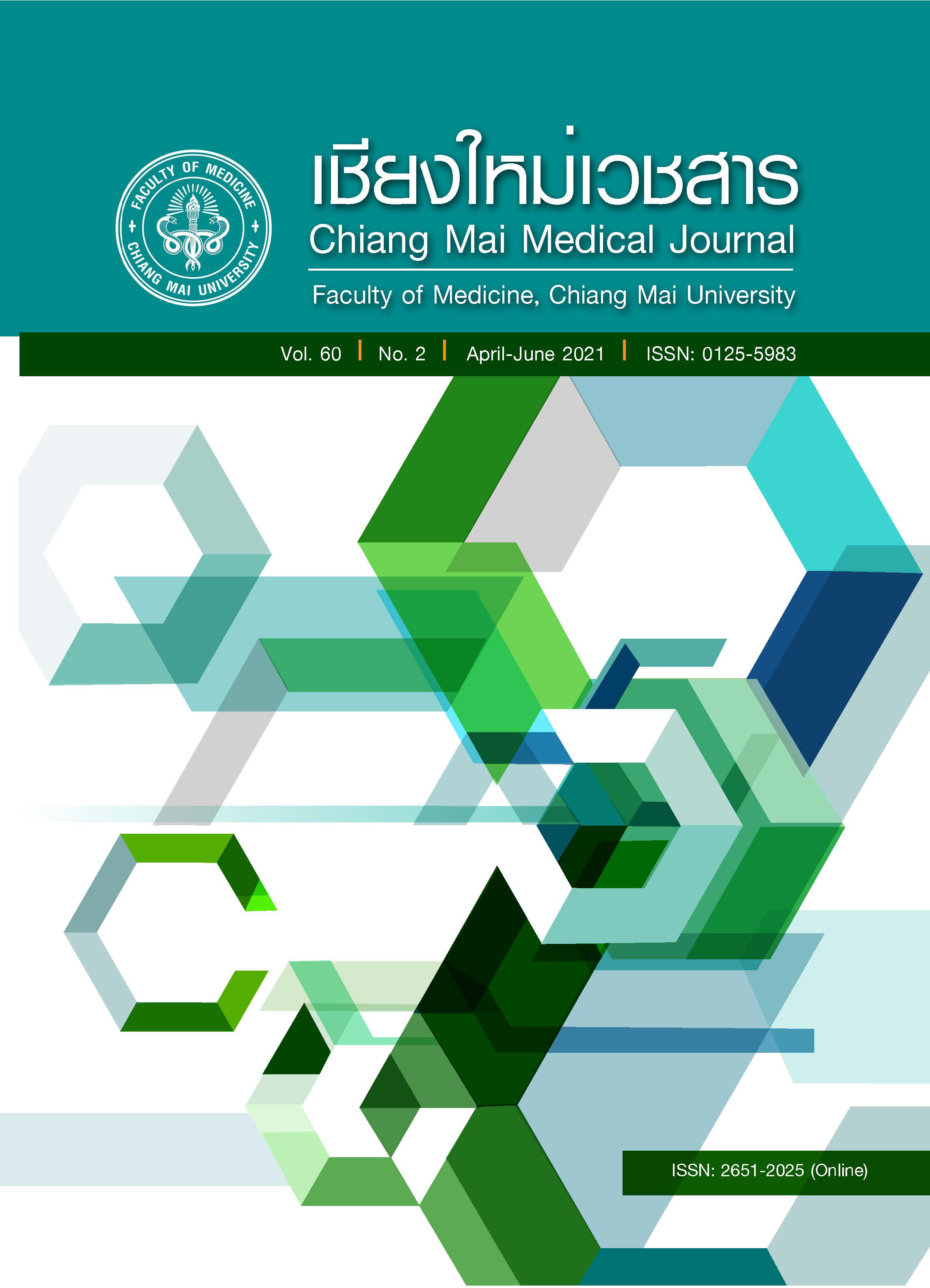Self-management activities and diabetes control of diabetic patients in Muang district, Nan province
Keywords:
Diabetes, Self-efficacy, SDSCAAbstract
Objectives To evaluate the prevalence of uncontrolled diabetes and diabetic self-care activities in type 2 diabetic patients in Muang District, Nan Province and to explore the association between self-care activities and glycemic control.
Methods Participants were interviewed for general information, self-care activities and self-efficacy. Self-care activities in diabetic patients were assessed using the Summary Diabetes Self-Care Activities (SDSCA) questionnaire. Hemoglobin A1c (HbA1c) was collected to evaluate glycemic control. The data was analyzed using logistic regression analysis.
Results Of 222 patients, more than half (56.76%) had poor glycemic control. Using multivariate regression analysis, lower SDSCA scores in diet and foot care activities were found to be associated with poor glycemic control (adjusted odds ratio = 2.29, p < 0.001 and adjusted odds ratio = 1.52, respectively; p-value 0.022).
Conclusion The majority of the diabetic patients had poor glycemic control. Healthy diet is an important factor in good glycemic control. The association between foot care activity and glycemic control may not be straight forward; however, good foot care may represent adherence to prescribed diabetes treatment and appropriate life-style modification.
References
International Diabetes Federation. IDF Diabetes atlas. 9th ed. Brussels, Belgium: International Diabetes Federation; 2019. p. 1-10.
Division of Non Communicable Diseases. Number and incident of admission 2016-2018 (จำนวนและอัตราผู้ป่วยในปี 2559-2561). Ministry of public health; 2016. [in Thai]
Diabetes Association of Thailand under The Patronage of Her Royal Highness Princess Maha Chakri Sirindhorn. Clinical Practice Guideline for Diabetes 2017th ed. Romyen media company limited; 2017. [in Thai]
Kasper D, Hauser S, Jameson L, Fauci A, Longo D, Loscalzo J. Harrison’s Principles of Internal Medicine. 19th ed. McGraw-Hill: Education; 2012. p. 2422-30.
Kulprateepunya K, Viriyaseubpong P, Viboon- chai R, Kosalawit T. Self-care behaviors of diabetic risk group in South-Esan, Thailand. The Southern College Network Journal of Nursing and Public Health. 2017;4:19-33. [in Thai]
Suratana S, Sasivimonlux K, Kruejak K, Mongkolthep W. The relative factors of self-care behaviors of diabetes mellitus patients in Mae Chan district, Chiang Rai. Journal of Community Development and Life Quality. 2015;4:297-307. (in Thai).
Charoennukul A, Suriyo Y, Treenon P. Rela-tionship Between the Level of Self-Care Ability and HbA1C in Uncontrolled Type 2 Diabetic Patients. Nurs J Minist Public Heal. 2012;12:37-48. [in Thai]
Kanglee K. Factors associated with glycemic control among people with type 2 diabetes mellitus at Phramongkutklao Hospital, Bangkok. Journal of The Royal Thai Army Nurses. 2014;15:256-68. [in Thai]
Van Der Bijl JJ, Van Poelgeest-Eeltink A, Shortridge-Baggett L. The psychometric properties of the diabetes management self-efficacy scale for patients with type 2 diabetes mellitus. J Adv Nurs. 1999;30:352-9.
Toobert DJ, Hampson SE, Glasgow RE. The Summary of Diabetes Self-Care. Diabetes Care J. 2000;23:943-50.
Schmitt A, Gahr A, Hermanns N, Kulzer B, Huber J, Haak T. The Diabetes Self-Management Questionnaire (DSMQ): Development and evaluation of an instrument to assess diabetes self-care activities associated with glycaemic control. Health Qual Life Outcomes [Internet]. 2013;11:1. [cited 2020 June 23].Available from: Health and Quality of Life Outcomes
Ha-upala A, Saibuathong N. Blood Glucose Control in Diabetes Patients with Current Smokers and Ex-smokers. Mahasarakham Hospital Journal. 2018;15:69-77.
Division of Non Communicable Diseases, Guided strategy for prevention and control of NCDs and injuries fiscal year 2020 (แนวทางการดำเนินงานป้องกันควบคุมโรคไม่ติดต่อและการบาดเจ็บ สำหรับพื้นที่ปีงบประมาณ พศ. 2563). Ministry of public health; 2020. p. 1-14. [in Thai]
Nather A, Cao S, Chen JLW, Low AY. Prevention of diabetic foot complications. Singapore Med J. 2018;59:291-4.
Iraj B, Khorvash F, Ebneshahidi A, Askari G. Prevention of diabetic foot ulcer. Int J Prev Med. 2013;4:373-6.
Tsourdi E, Barthel A, Rietzsch H, Reichel A, Bornstein SR. Current aspects in the pathophysiology and treatment of chronic wounds in diabetes mellitus. Biomed Res Int. 2013;385641.
Wynn Nyunt S, Howteerakul N, Suwannapong N, Rajatanun T. Self-efficacy, self-care behaviors and glycemic control among type-2 diabetes patients attending two private clinics in Yangon, Myanmar. Southeast Asian J Trop Med Public Health. 2010;41:943-51.
Saudek CD, Derr RL, Kalyani RR. Assessing glycemia in diabetes using self-monitoring blood glucose and hemoglobin A1c. J Am Med Assoc. 2006;295:1688-97.
Downloads
Published
How to Cite
Issue
Section
License

This work is licensed under a Creative Commons Attribution-NonCommercial-NoDerivatives 4.0 International License.










